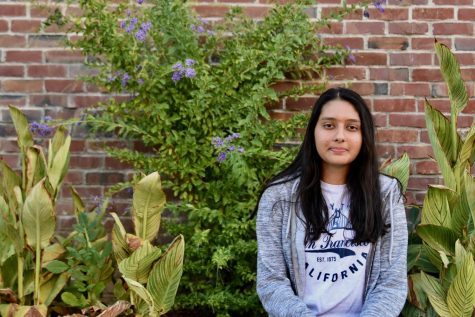The Islam I see
My experience covering a local mosque
April 12, 2019
Walking into a room where you know you’re going to be the outsider, where you know your presence will make people uneasy, is a difficult thing.
As another reporter and I walked with the tide of Muslim men, women and children into the Prospect Community Center, where Friday Islamic prayers are held for members of the West Valley Muslim Association, we received many side glances and double takes. Maybe it was our lack of hijabs or our cameras that immediately labelled us as outsiders, but I forced myself to keep walking. At the door, we slipped off our shoes with the rest of the crowd and walked in.
I immediately had no idea what to do. The men and boys sat in rows on the floor at the front of the room, the women and girls at the back. Every single woman wore a hijab. There was clearly no place for us. After a moment of lingering in the doorway, we saw a niche in the wall and ducked in.
We stood there, waiting for the prayer to start, trying to pretend people weren’t staring at us, awkwardly fiddling with the cameras to look busy. Then, a woman approached me.
“Would you like a shawl to cover your hair?” she asked gently.
I quickly launched into my explanation: I was a reporter from the local high school, I was doing a feature on the Muslim community and I was here to interview some people, with the prayer leader’s permission. I left out the part about having hijabs in the car but ditching them last second because we thought they would only draw more attention to us.
The woman nodded, still looking a little uneasy, then retreated back to her row, leaving us in our little corner. Then, the prayers started. The Imam, who led the service, talked about leading an upright life, making moral decisions and not succumbing to human faults. His words seemed almost familiar to me, echoes of what I’d heard in Hindu temples years ago, when my family still regularly visited the temple. The Imam spoke of morals and lessons that were also taught in a Christian church or a Hindu temple— yet Islam is more antagonized while other religions are typically respected. As I watched the entire room of men, women and children kneel as one body and echo back the prayer in one voice, I thought of the complete unfairness of Islamophobia. These people were here to pray and encourage peace but were depicted as villains.
After the prayer ended, people started to mingle, greeting one another as they filed out. As we awkwardly tried to blend into the swarm of people, a lady approached us and interrogatively asked why we had cameras and whether we were photographing people. We jumped into explaining, but she continued, saying we couldn’t intrude on prayers or photograph people without their consent. This type of confrontation had been exactly what we’d been dreading.
Just then, another lady approached us. I expected her to join the first woman, but instead she smiled warmly and told us she wanted to thank us for covering their community. She acknowledged the difficulty of coming somewhere when you know that you’re the outsider. She also said that as a Muslim, she is appreciative of all efforts non-Muslims make to understand Islam and then apologized for the other lady’s confrontation.
The lady’s eloquence and silent strength astounded me. After she described the hateful people she had encountered throughout her life, I was amazed at how she could be so gracious and open with us. Her resilience and ability to see good in a broken world has come to define strength to me.
The rest of the people I talked to all shared their own stories about dealing with Islamophobia, raising their kids in a society that hated their religion and still choosing to live by the Quran everyday. They wanted me to understand their religion and they wanted to make the world see Islam for what it is: a religion of peace.
After talking with them, I even understood the first lady’s attitude. Everyday, she has to go into the world and face others’ judgement and criticism of her religion, constantly fighting to convince people that she believes in peace, not violence. It makes sense for her to be uneasy of outsiders when they’ve repeatedly shown her distrust and hatred.
But that first lady isn’t what I remember from the mosque. I remember the kind man who offered us pizza and then told us the story of his childhood in Syria. I remember the group of kids chasing each other around the lawn, around their mothers’ legs. I remember the rowdy middle school boys bantering with each other, trading insults and wrestling each other like all middle school boys do. I remember the first lady’s sincerity and her silent resilience. And to me, that is the face of Islam.
That day, when I came home and started transcribing my interviews, I realized the power I hold as a journalist. Society has mercilessly antagonized Islam, but this was my chance to allow Muslim people to take back the narrative, to actually speak rather than be dictated. I’m honored that they welcomed me into their midst and trusted me with the responsibility to tell their side of the story. I hope I’ve done right by them.
















